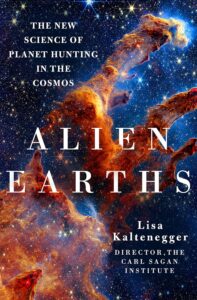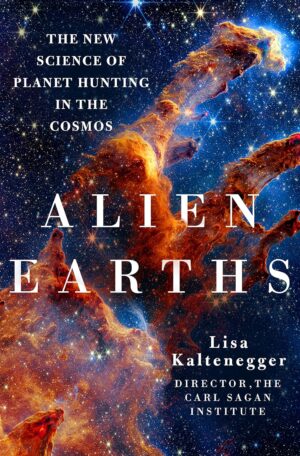Alien Earths
By Lisa Kaltenegger
St. Martin’s Press
Publication date: April 16, 2024

With her new book, Alien Earths, Lisa Kaltenegger has established herself as the legitimate successor to Carl Sagan. Alien Earths is the most readable astronomy book I’ve ever read. That’s a huge compliment, but it’s well deserved. Kaltenegger, Director of the Carl Sagan Institute to Search for Life in the Cosmos at Cornell University, has written a book that is scientifically informative, exciting, and personal. As a leading figure in the search for life on other planets, Kaltenegger has told the story of that search from both the perspective of the history and progress of the scientific approach to the issue and the perspective of her own entry into the field and her approach to addressing the problem. In the course of doing so, the reader learns something of the basic science involved, the discoveries that have been made so far, and is given a vivid description of our cosmos as we currently understand it. She inserts just enough personal anecdotes to make us feel as if she’s telling us a story, not just presenting us with facts.
For an amateur, I’m reasonably well-versed in astronomy and planet science, but Alien Earths taught me a lot that I didn’t know. I learned that many of the exoplanets orbiting other stars that were discovered early are gas giants, somewhat like Jupiter, circling their stars in near orbits, close enough to cause a detectable wobble in the star. I learned that some burnt out stars continue to have planets orbiting their cold husks. I learned that small tardigrades, water animals barely large enough to be seen with the naked eye can survive in space and remain dormant for a hundred years. An Israeli moon shot that crash-landed may have dumped thousands of tardigrades on the moon, and they may be living there in a dormant state right now.
I’m a science fiction writer and I consume as much space science as I’m able to understand. One of the best things I gained from reading Alien Earths was an appreciation of how Earth has changed over the four and a half billion years it has existed and how those changes might appear to an outside observer. We think of our planet as mostly covered in oceans and continents with green vegetation, but most of us forget that it has not always been that way. The green vegetation that colors our planet wasn’t here before 750 million years ago, and the additional oxygen it helped to produce wasn’t sufficient to sustain the lives of mammals like us until 650 million years ago. There was a time in Earth’s past when it would have appeared black to an extraterrestrial observer, even a time when, because of the presence of oxygen but no plant life, the surface of the planet would have appeared red, like that of Mars. What Kaltenegger realized is that in our search for other planets that might support life, we might observe some of them at a time in their history when they resembled Earth in its distant past. She worked on developing light-spectrum “signatures” of these early stages of our planet in order to try to spot exoplanets that might be in one of these stages—perhaps a future Earth.
Thinking that our own planet is only at one stage in its progression and that it may be that only at this stage is it able to support human life, and at the same time realizing that there are countless other planets that have already passed such a stage or will only arrive there sometime in the future, so the prospect of other life in the universe is a dynamic one, changing over time, provides a certain perspective. We humans occupy not just a tiny speck of territory in a vastly large universe, but also a tiny slice of time in a vastly long universe-wide saga. Our presence on the universal stage is almost infinitely small. It’s a sobering thought. It’s also awe-inspiring, and the author manages to convey her own sense of wonder and awe at the discoveries that lead to such a perspective throughout her book. There are hints that she sees humanity’s future as not being tied to our planet, and perhaps not being tied to such a small slice of time.
Alien Earths is not fiction, it is not even mostly speculation. It is primarily science but written with the spirit and flair of a novel. It accomplishes what the best novels accomplish and that is to affect the reader’s perspective on the world and their sense of self. It does so by showing us what we know about the nature of our planet and the universe in which it and we exist. For a science fiction writer such as myself, it is full of information that fuels the imagination. For any reader it is a thrilling introduction to the stars, planets, and the cosmos.
Want to read science-based science fiction? Read Casey Dorman’s Voyages of the Delphi novels: Ezekiel’s Brain and Prime Directive. Available on Amazon. Click Here!

Subscribe to Casey Dorman’s Newsletter. Click HERE





